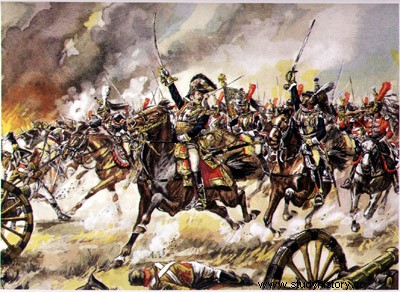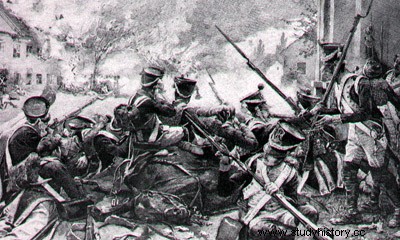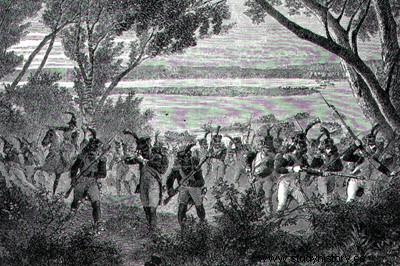-

- Spain in Essling
The Battle of Essling, sometimes called the Battle of Aspern-Essling or the Battle of Aspern, was a battle between French and Austrian troops, in the suburbs of Vienna, from May 20 to 22, 1809. Ells ended in the death of 45,000 soldiers from both armies, and in particular, on the French side, by that of Jean Lannes, who died on May 31 as a result of wounds received on the 22nd.
In 1809 Austria, seeing Napoleon bogged down in the interminable war in Spain and feeling its fragile alliance with Russia, decided to go on the attack to avenge the humiliation of Austerlitz.
While Austria goes on the attack in Bavaria, Napoleon manages to gather an immense army in Germany, but of lesser “quality” than his veteran units in Spain. He manages to beat the Austrians at Eckmühl, then wins the siege of Regensburg. Napoleon quickly reached Vienna, but the Austrian army, withdrawn in good order north of the Danube, was not at all destroyed and Austria refused peace.
While Napoleon occupied Vienna, the Archduke, after having destroyed the bridges over the Danube, regroups his army five kilometers northeast of the capital, near Bisamberg, a height on the left bank of the river. The French must cross the Danube. Lobau, one of the many islands that divide the river into minor channels, is chosen as a crossing point. On the night of May 19-20 bridges were thrown across the canals from the right bank to the occupied island of Lobau, on the evening of the 20th. Many men were assembled there and a bridge was thrown over the last arm of the Danube, between Lobau and the left bank. Masséna's divisions immediately crossed over to the left bank and dodged the Austrian outposts.
-

- Molitor division in Essling
Pressed by energetic attacks on his rear, Napoleon ferried all available troops to the bridges, and at dawn on the 21st, 40,000 men were assembled on the left bank, in the wide plain of Marchfeld, which will be a little later the scene of the battle of Wagram.
The Archduke did not resist the passage. His intention was to let a fairly large force cross, and attack him before the rest of the French army could come to his aid. Napoleon accepts the risk of such an attack, but he seeks to reduce the risk by calling in every available battalion. His forces on Marchfeld are assembled in front of the bridges, and now have the village of Aspern (Gross-Aspern) to their left and Essling (or Esslingen) to their right. Aspern, is located on the bank of one of the arms of the river and cannot be circumvented by the left. The French advance on a front that connects the two villages.
Hiller, Bellegarde and Hohenzollern were to converge on Aspern, to attack Essling. The Austrian cavalry is in the center, ready to retaliate against any attack by the French cavalry at the head of the columns. On the 21st the bridges became more and more unstable, due to the violence of the current, but also to the flood of soldiers crossing without interruption all day and night.
First day
The battle begins in Aspern. Hiller wins the village in the first assaults, but Masséna takes it back, and defends his conquest with the same tenacity he showed at Marengo. The French infantry fights with the courage that it has so lacked in recent battles.
The three Austrian columns fail to reconquer more than half of the village. The position is still held by Masséna when night falls. Napoleon tried to create a diversion, sending his centrally located cavalry to charge the enemy's artillery, deployed in a long front line concentrated on Aspern. The first charge of the French is repulsed, but the second consists of a heavy mass of cuirassiers. The French horsemen drove off the gun crews, bypassed the Hohenzollern infantry positions, and resisted the Lichtenstein cavalry, but they could do no more and finally retreated to their old positions.
Meanwhile, Essling is the scene of a fight almost as desperate as that of Aspern. The French cuirassiers brutally assault the flank of Rosenberg's force, and withstand an assault. In the village, Lannes resists valiantly with a simple division, until night puts an end to the battle. The two armies bivouac on the spot. In Aspern French and Austrians still clash with guns. The emperor is not discouraged, and comforts every able-bodied man.
Second day
At dawn on the 22nd the battle resumed. Masséna releases Aspern from the enemy, but at the same time Rosenberg storms Essling. Lannes, who was still resisting desperately, received reinforcements from Saint-Hilaire's division, and pushed Rosenberg back. In Aspern, Masséna was in turn pushed back by a counter-attack from Hiller and Bellegarde.
-

- Voltigeurs de Molitor à Lobo
Napoleon launches a major attack on the Austrian center. The entire French center, with Lannes on the left side and the cavalry in reserve, advanced. The Austrian line is broken between Rosenberg's right and Hohenzollern's left. The victory is almost won when the Archduke Charles gives his reserve, leading his soldiers colors in hand. Aspern is lost. The bridges over the Danube, which had once already been destroyed, are broken again by heavy barges, which the Austrians have allowed to be carried away by the current.
Essling now fell to another onslaught from Rosenberg. This one then directs its efforts on the French center, which withdraws slowly from banks. Retirement is terribly expensive. The general exhaustion of both sides puts a definitive end to the fighting.
Consequences
The French lost 21,000 of the 90,000 successively engaged. Napoleon lost one of his best officers:Marshal Jean Lannes, who died a few days later from his wounds.
On the night of the 22nd, the last bridge was repaired, the French withdrew to await the arrival of reinforcements at Lobau.
